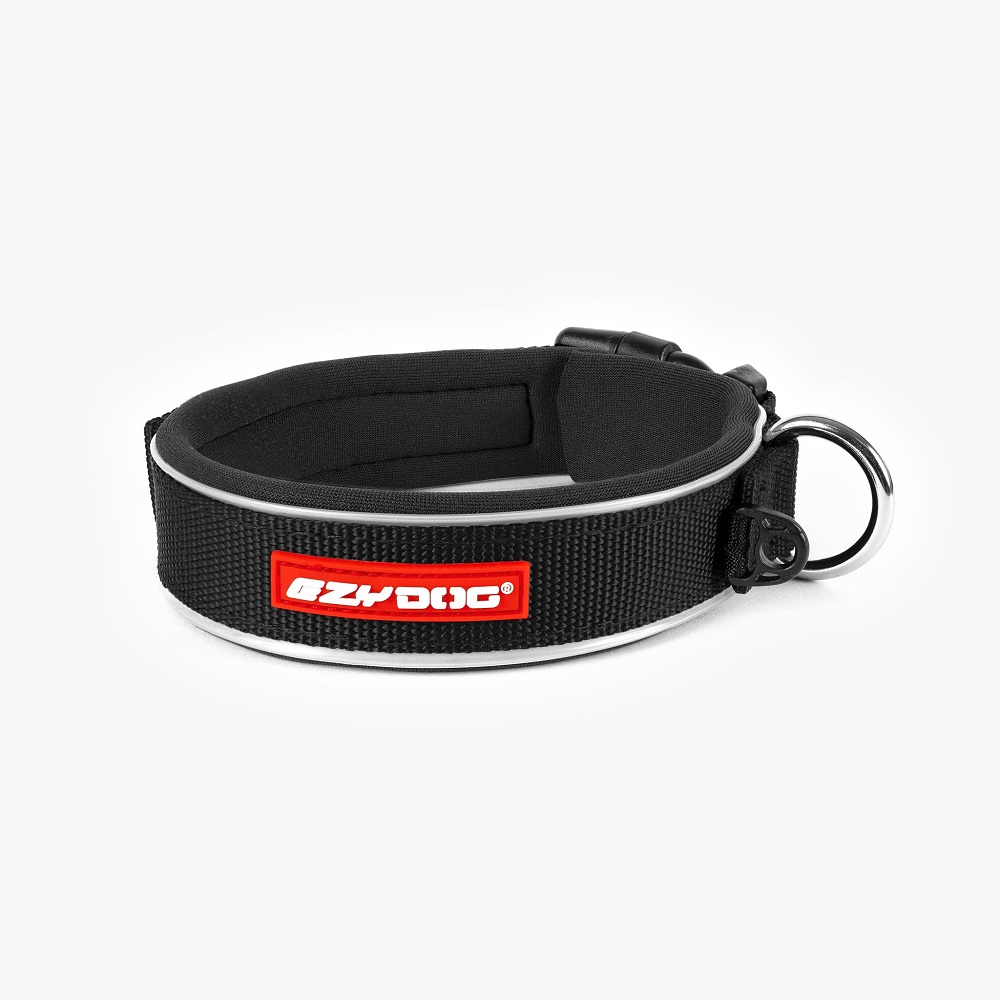Selecting the right dog collar is a crucial decision for any pet owner, playing an essential role in your dog’s safety, comfort, and training. With various types of collars available, each specifically designed to suit different breeds and purposes, it’s important to understand which collar will work best for your canine companion. This comprehensive guide explores essential tips for every breed when it comes to choosing the right dog collar.
Understanding the Different Types of Dog Collars
Flat Collars: The Most Common Type
Flat collars are perhaps the most common type of dog collar. Made from nylon or leather, they are designed to be worn daily by dogs that are friendly and well-behaved. Flat collars usually come with a buckle or snap closure and feature a D-ring for attaching identification tags and leash. For most breeds, flat collars are suitable due to their comfort and simplicity, but they must be fitted correctly to avoid slipping off or causing discomfort.
When choosing a flat collar for your dog, consider their size, breed, and activity level. For instance, a smaller breed like a Chihuahua will need a lighter, adjustable collar, while a larger breed, such as a Labrador Retriever, may require a more robust collar. Furthermore, flat collars come in various styles, colors, and patterns, allowing you to select one that matches your dog’s personality. However, it is important to remember that flat collars may not be sufficient for training or controlling more energetic or stubborn breeds.

Martingale Collars: A Training Tool for Sighthounds
Martingale collars are particularly popular for sighthounds and dogs with narrow heads. They have a unique design that tightens when the dog pulls, preventing them from slipping out of the collar. This makes martingale collars an excellent choice for breeds like Greyhounds and Whippets. The gentle tightening feature offers better control without choking the dog, making it a humane option for training purposes.
These collars are typically made of nylon and feature a metal ring that allows for adjustments. Proper sizing is crucial; the collar should fit snugly around the dog’s neck without being too tight. For breeds prone to escaping, the martingale collar provides a secure fit while allowing freedom of movement, making it an ideal choice for training sessions and walks. Owners should ensure that this collar type is used responsibly to avoid frequent tightening, which could lead to stress or anxiety for the dog.
Consider Your Dog’s Breed and Size
Importance of Size When Choosing a Collar
Choosing the right collar is not solely based on aesthetics; it must consider the dog’s size and breed. A collar that fits one breed perfectly may not be suitable for another because of differing neck sizes and strengths. Generally, the collar should be snug enough that two fingers can fit between the collar and the dog’s neck, avoiding any risk of it slipping off.
Smaller breeds, such as Teacup Poodles or Yorkshire Terriers, require lightweight collars with soft fabrics to prevent injuries to their delicate necks. On the other hand, larger breeds, such as Rottweilers or Mastiffs, may necessitate heavier-duty collars that can withstand strength and pulling力 during walks.
As a dog owner, you must invest in a collar that is comfortably fitting for your dog while keeping their safety in mind. Regularly check the collar for any changes and make necessary adjustments as your dog grows to maintain comfort and control.
Understanding Breed Tendencies and Behavior
Different dog breeds possess unique tendencies and behaviors that can influence the type of collar they require. For instance, hunting breeds like Beagles may require a collar that can withstand frequent tugging and pulling, while lap dogs that are mostly indoors may prefer a more comfortable, decorative option. Understanding your breed’s natural behaviors is vital in choosing a collar that will suit their lifestyle.
Additionally, some breeds are more inclined to escape than others. If you have an adventurous breed, such as a Jack Russell Terrier, a highly durable collar with a reliable fastening mechanism will be crucial. Breeds that are strong pullers, such as Bull Terriers or Siberian Huskies, will benefit from collars that distribute pressure evenly and provide better control.
In this regard, a thorough understanding of your dog’s breed characteristics can enhance your decision-making process when selecting the ideal collar. Additionally, consulting with a veterinarian or a professional dog trainer specific to your breed can provide valuable insights into the best collar options based on behavior and activity level.

Safety Features to Look for in a Dog Collar
Reflective and LED Collars for Improved Visibility
When looking for a dog collar, safety features should always be a primary consideration. Reflective or LED collars are especially important for dogs who enjoy evening walks or playtime after dark. Collars equipped with reflective materials enable drivers and passersby to see your furry friend from a distance, ensuring safety during low-light conditions.
Similarly, LED collars come with built-in lights that illuminate while your dog is outdoors, increasing visibility not just for vehicular traffic but also for you as an owner. The combination of LED technology with reflective materials offers the highest level of visibility and safety for your dog, making it ideal for nighttime adventures.
As visibility is critical to ensuring safety, investing in a collar with these features is of great importance, particularly for breeds that are usually active or excitable outdoors. Additionally, keeping your dog’s collar intact and functional will help reduce the potential for accidents or lost dogs, providing peace of mind for owners.
Breakaway Collars for Added Safety
Breakaway collars are designed with safety in mind, featuring a quick-release mechanism that allows the collar to come off easily in case it gets caught on a branch or any other object. This feature is incredibly important for dogs that love to explore or frequently play outdoors.
However, breakaway collars should primarily be used in non-leash situations, such as when your dog is playing in a yard or park, as they may not be suitable for walking or training. When assessing whether a breakaway collar functions satisfactorily, gently pull on the collar to ensure the mechanism works without putting undue pressure on the animal.
Overall, breakaway collars can provide an excellent safety net, particularly for adventurous dogs or those who enjoy off-leash activities. Always consider the activity level and behavior of your breed when determining whether a breakaway collar is right for your dog.
Materials and Comfort: What to Consider
Choosing Breathable and Comfortable Materials
Another significant factor in choosing the right dog collar is the material used in its construction. The collar should be made from breathable, comfortable materials that won’t irritate your dog’s skin or fur. Common materials include nylon, leather, and cotton. Each has its own benefits and drawbacks.
Nylon collars are durable and come in an array of colors and designs. They are also lightweight, making them ideal for smaller breeds as well as active dogs. Leather collars are stylish and robust; however, they may not be as breathable as other materials. For dogs with long fur, a cotton collar can be an excellent choice, providing comfort and aesthetics without causing matting or irritation.
To assess comfort levels, consider your dog’s lifestyle and coat type. For instance, dogs that engage in a lot of outdoor activities may benefit from breathable materials that wick away moisture, while house pets may prefer softer, more cushioned options. Always look for collars lined with padding or made from soft, non-irritating materials.
Measuring for Comfort and Fit
Proper sizing is essential when it comes to your dog’s comfort. An ill-fitting collar can cause discomfort, lead to skin irritation, or even pose choking risks. To find the correct size, measure your dog’s neck using a fabric tape measure. If you don’t have one, a piece of string can also work, just measure the length against a ruler afterward.
After obtaining the measurement, add about two inches to ensure a proper fit. Different manufacturers have different sizing charts, so be sure to check compatibility based on the brand’s specifications. Ultimately, keep in mind that the collar should allow for adjustment; as your dog grows or gains/losses weight, you should be able to modify the fit as needed.
To prevent accidents or injuries, regularly check the collar for any signs of wear and tear. Following the above steps will help ensure the collar remains comfortable and functional for your dog.

Taste and Style: Finding the Right Look
Reflecting Your Dog’s Personality
Just as humans have their own unique sense of style, your dog’s collar can also reflect their personality. When choosing a collar, consider colors, patterns, and decorative elements that match your dog’s character. Fashion accessories like bows, bandanas, or charm tags can enhance the overall look, allowing your dog to stand out and showcase their individuality.
Moreover, many companies now offer customizable collars that allow pet owners to choose specific designs, colors, or even engrave names and numbers. This not only adds a personal touch but also promotes safety, ensuring that your dog can easily be identified if they wander off. The collar becomes a part of their identity, portraying their personality and indicating their unique status in your life.
Tailoring to Each Breed’s Characteristics
In addition to personal preference, it’s essential to consider your dog’s breed when selecting collar styles. For example, small breeds like Dachshunds may benefit from lightweight and colorful collars, while large breeds, such as Great Danes, may require wider, sturdier collars. Select a design that harmonizes with your dog’s breed and overall appearance, while still focusing on comfort and functionality.
In conclusion, finding a collar that aligns with your dog’s personality beautifies their experience while wearing it. Whether you value aesthetics or practicality, the right choice elevates your dog’s overall look while ensuring their safety and comfort.
Maintenance and Longevity of Dog Collars
Caring for Your Dog’s Collar
Taking good care of your dog’s collar not only prolongs its life but also ensures your pet’s safety. Regularly inspect the collar for signs of wear and tear, paying attention to fasteners, fabric, and stitching. Washing your dog’s collar according to the manufacturer’s instructions is important, particularly if it has become dirty or smelly from regular use.
Most nylon collars can be machine washed, while leather collars often need conditioning to prevent cracking. If your dog enjoys outdoor adventures, it’s wise to invest in a collar that can be easily cleaned or is resistant to dirt and moisture. Regular maintenance can prevent accidents caused by a worn-out collar.
Replacing Collars at the Right Time
As your dog ages or as circumstances change, collar needs may alter. Collars should replace when they show significant wear, have broken fasteners, or when they no longer fit properly. Regular monitoring prevents any discomfort for your dog that comes from wearing a worn or ill-fitting collar.
Moreover, certain situations, testing new collars through training, or experiencing puppy growth spurts can warrant selecting a new collar more frequently. By understanding the importance of collar maintenance, you contribute to your furry friend’s health and happiness.
Conclusion: Making the Right Collar Choice for Your Dog
In conclusion, choosing the right dog collar is a thoughtful process that involves understanding various aspects such as breed, materials, sizing, aesthetics, and safety features. Investing time in selecting the right collar not only enhances your dog’s comfort but also fortifies their well-being, ensuring safety, style, and functionality.
When assessing the right collar for your dog, prioritize their unique needs and remember that what works for one breed may not work for another. With the essential tips provided, pet owners can confidently select a collar that reflects their dog’s personality while keeping them safe and comfortable every step of the way. Whether your dog is small or large, rambunctious or relaxed, the right collar is out there, waiting to discover!










